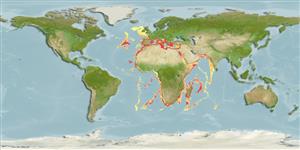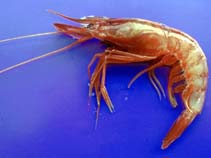Aristeus antennatus (Risso, 1816)
Blue and red shrimp| Native range | All suitable habitat | Point map | Year 2050 |

|
| This map was computer-generated and has not yet been reviewed. |
| Aristeus antennatus AquaMaps Data sources: GBIF OBIS |
Классификация / Names народные названия | синонимы | CoL | ITIS | WoRMS
Malacostraca | Decapoda | Aristeidae
Environment: milieu / climate zone / пределы глубины / distribution range экология
; пределы глубины 80 - 3300 m (ссылка 127635), usually 350 - 800 m (ссылка 80214). Tropical, preferred 19°C (ссылка 107945); 49°N - 30°S, 41°W - 75°E
Distribution страны | регионы FAO | Ecosystems | места находок | интродукции
Eastern Atlantic, Mediterranean and Western Indian Ocean: from Brazil to France, south to Natal, South Africa and east to Maldives.
Length at first maturity / Size / Weight / Возраст
половая зрелость: Lm 3.2 range ? - ? cm Max length : 22.0 cm TL самец/пол неопределен; (ссылка 8); 7.1 cm CL (female); наибольший возраст (опубликованны данные): 6 годы (ссылка 80242)
Life cycle and mating behavior половая зрелость | размножение | нерест | Eggs | Fecundity | Larvae
Основная ссылка
ссылки | координатор | соавторы
Holthuis, L.B. 1980 FAO Species Catalogue. Vol. 1. Shrimps and prawns of the world. An annotated catalogue of species of interest to fisheries. FAO Fish. Synop. 125(1):271 p. Rome: FAO. (ссылка 8)
Статус Красного Списка МСОП
(ссылка 130435: Version 2025-1)
Статус СИТЕС (ссылка 108899)
CMS (ссылка 116361)
Угроза для людей
Использование человеком
рыболовство: важный объект промысла
FAO - рыболовство: landings, Видовой профиль | FIRMS (Stock assessments) | FishSource | Sea Around Us
инструменты
дополнительная информация
ресурсы в Интернет
BHL | BOLD Systems | CISTI | DiscoverLife | FAO(рыболовство: Видовой профиль; publication : search) | Fishipedia | GenBank (Геном, Нуклеотид) | GloBI | Gomexsi | Google Books | Google Scholar | Google | PubMed | Tree of Life | Wikipedia (Вперёд, поиск) | Zoological Record



